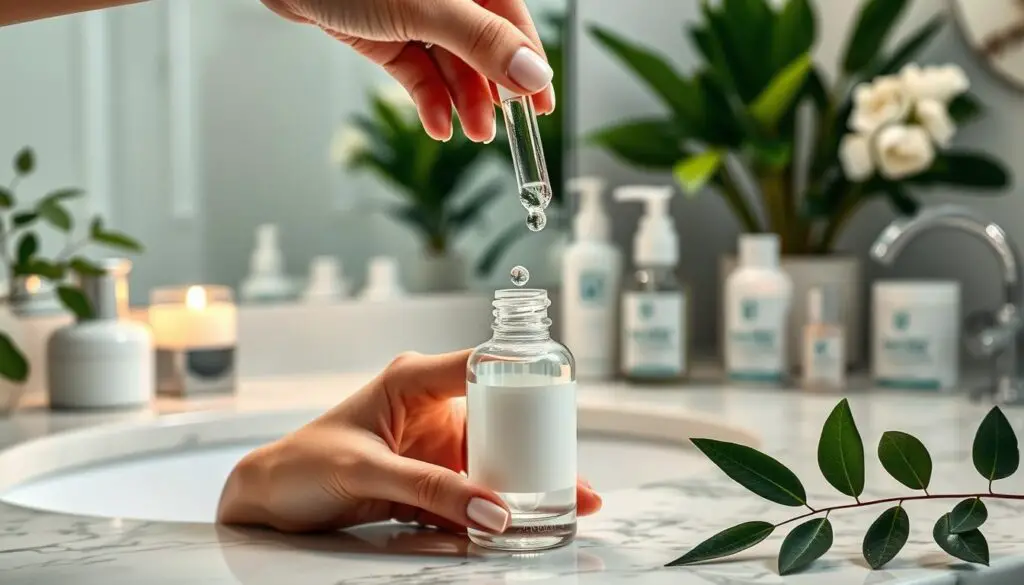Hyaluronic Acid in Skincare Routine: Ever wondered why your skin stays dry even with lots of moisturizers? The answer might be in knowing when to apply hyaluronic acid in your skincare.
Hyaluronic acid is a key ingredient that can hold 1000 times its weight in water. It’s a game-changer for keeping skin hydrated. Our bodies naturally make it, but making less as we age makes skin dry and aged.
Knowing when to use hyaluronic acid can change your skincare game. It works best on damp skin. This lets it lock in moisture and make your skin look plump and radiant.
Unlike other skincare products, hyaluronic acid is very flexible. You can use it every day, morning and night. It’s a great addition to your skincare routine.
Learning how and when to use hyaluronic acid can unlock your skin’s full potential. Are you ready to explore more about hyaluronic acid?
Table of Contents
Understanding Hyaluronic Acid
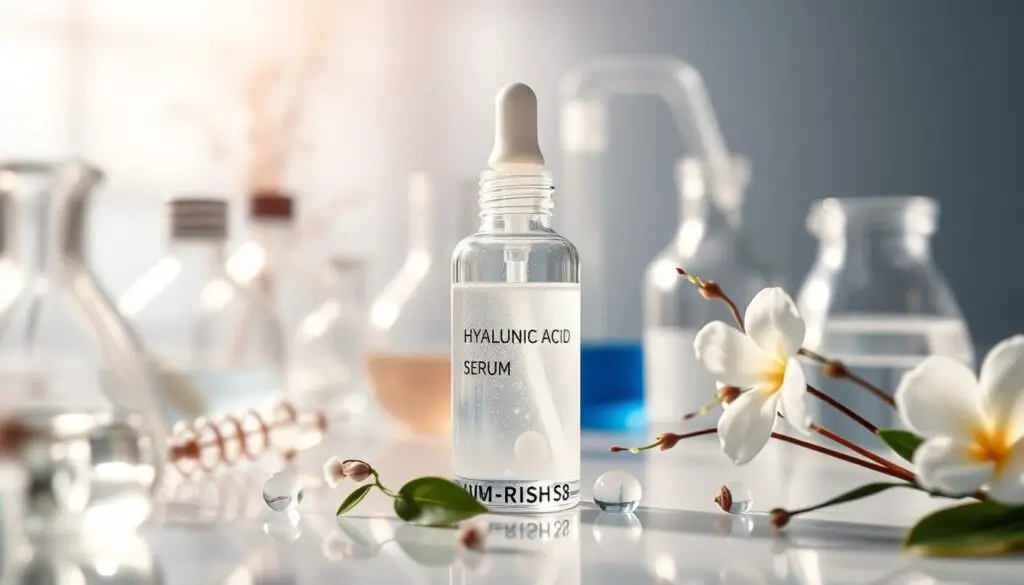
Explore the world of hyaluronic acid, a key skincare ingredient. It’s changing how we care for our skin’s moisture and health. Adding hyaluronic acid to your skincare routine could make your skin look radiant and hydrated.
What Is Hyaluronic Acid?
Hyaluronic acid is a natural substance in our bodies. It’s amazing at holding onto moisture. Incredibly, it can hold 1000 times its weight in water, making it a hero for skin hydration.
- Found naturally in human body tissues
- Decreases with age
- Critical for maintaining skin moisture
Benefits of Hyaluronic Acid for Your Skin
The best time to use hyaluronic acid is when your skin needs deep hydration. Its special properties offer many skincare benefits:
- Intense hydration for all skin types
- Helps reduce fine lines and wrinkles
- Supports skin’s natural healing process
- Suitable for sensitive skin
“Hyaluronic acid is clinically proven to help with topical treatment of skin concerns such as acne and rosacea.” – Dermatology Research
Whether you have dry, oily, or combination skin, hyaluronic acid can be a game-changer. It’s a great addition to your skincare routine.
The Best Time to Use Hyaluronic Acid
Figuring out the best time to use hyaluronic acid can change your skincare game. Knowing when to apply it is key to getting the most out of its hydrating powers. Since your skin’s moisture needs shift during the day, applying it at the right time is essential for a glowing look.
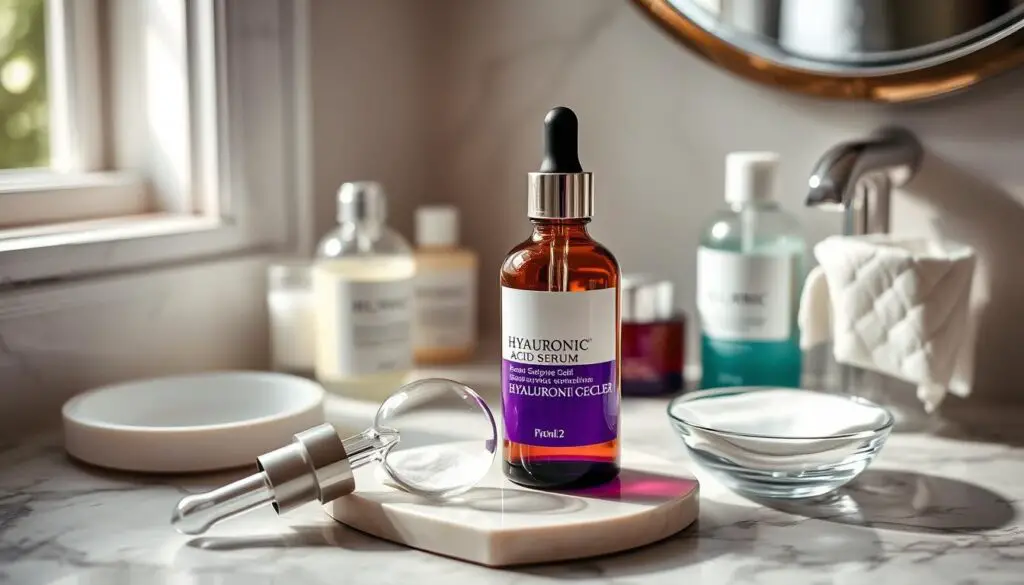
Morning vs. Evening Application
Dermatologists say to use hyaluronic acid twice a day for best hydration. The best way to use it is on damp skin after cleansing. This helps it soak in better.
- Morning Application: Apply a lightweight hyaluronic acid serum before your moisturizer and sunscreen.
- Evening Application: Put it on after you clean your face and before your night cream to keep moisture in.
Seasonal Considerations for Use
Your hyaluronic acid routine should change with the seasons. You might need more hydration in dry winters and less in humid summers.
“Hydration is not a one-size-fits-all approach. Listen to your skin’s unique needs.” – Skincare Expert
Here are some seasonal tips for using hyaluronic acid:
- Use more in cold, dry seasons to keep moisture in.
- Use less in humid summers to avoid feeling greasy.
- Adjust how often you use it based on how dry or oily your skin is.
How to Incorporate Hyaluronic Acid into Your Routine
Learning how to use hyaluronic acid can change your skincare routine. Knowing how to add it to your daily skincare is key. Derm La Fleur Anti-Aging Serum is a great start.
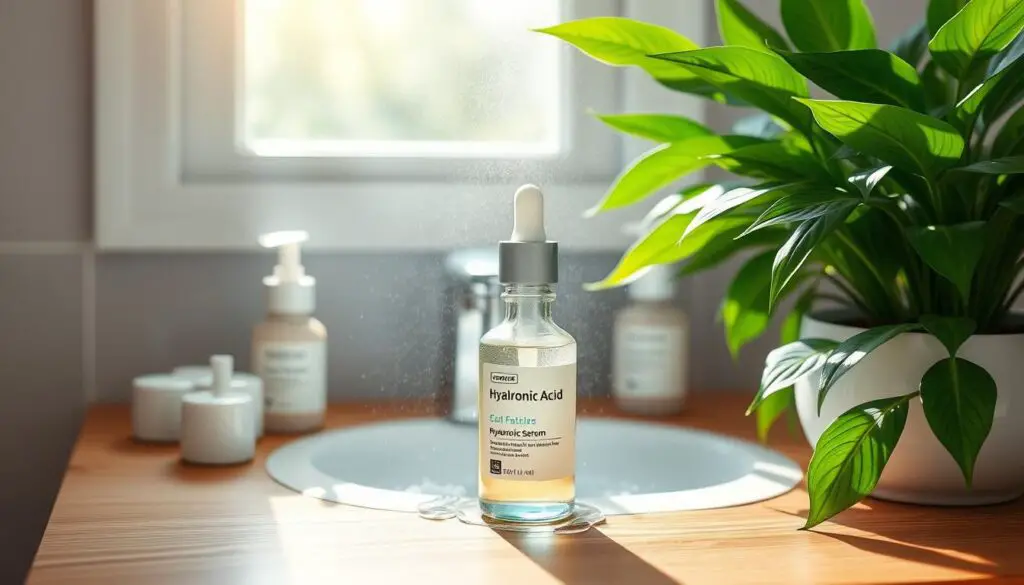
Step-by-Step Application Process
Getting the most out of hyaluronic acid needs a clear plan. Here’s what to do:
- Cleanse your face well
- Apply toner (if you like)
- Make sure your skin is a bit wet
- Pat the hyaluronic acid serum on gently
- Then, apply moisturizer
- Finish with sunscreen in the day
Pairing with Other Ingredients
Choosing the right mix of ingredients can boost your skincare. Here’s a guide to combining hyaluronic acid:
| Ingredient | Compatibility | Benefits |
|---|---|---|
| Retinol | Excellent | Softens retinol’s potential irritation |
| Vitamin C | Very Good | Enhances brightening effects |
| Niacinamide | Perfect | Supports skin barrier function |
“Layering skincare ingredients strategically can unlock your skin’s true potential.” – Skincare Experts
Remember, less is more with hyaluronic acid. A small amount, like a quarter, is enough. By adding hyaluronic acid wisely, you’ll see better hydration and younger-looking skin.
Choosing the Right Product
Finding the perfect hyaluronic acid product can change your skincare game. It’s all about what your skin needs. Knowing the different types and what they do is key.
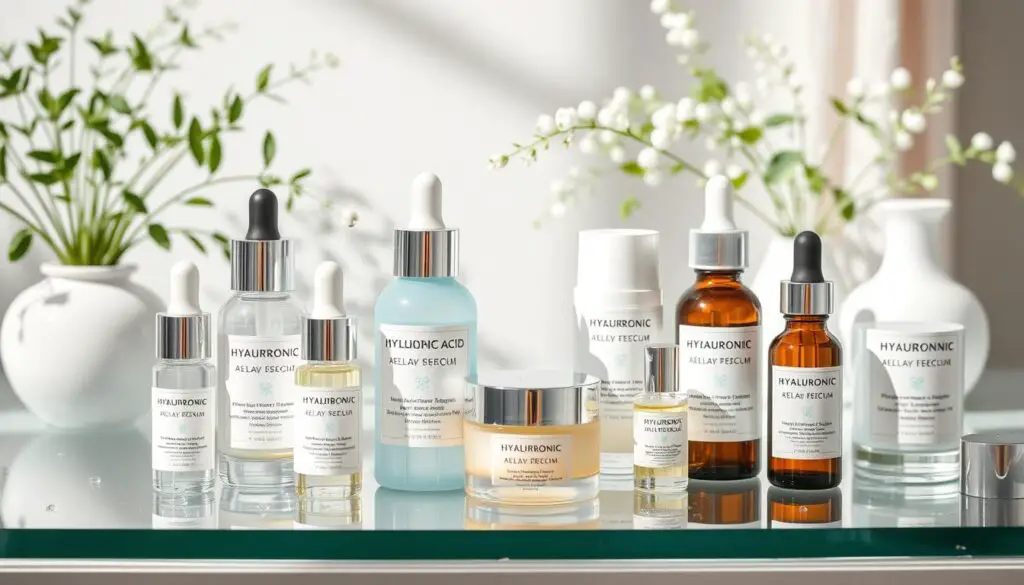
Types of Hyaluronic Acid Products
There are many ways to use hyaluronic acid in your routine:
- Serums: Lightweight and fast-absorbing
- Creams: Rich and deeply moisturizing
- Sheet masks: Intensive hydration treatment
- Moisturizers: All-in-one hydration solution
Understanding Molecular Weight Matters
The molecular weight of hyaluronic acid is crucial. It affects how well it works on your skin:
| Molecular Weight | Skin Penetration | Primary Function |
|---|---|---|
| Low Weight | Deepest layer | Nutrient absorption |
| Mid Weight | Middle layers | Hydration support |
| High Weight | Surface level | Plumping wrinkles |
What to Look for on Labels
When picking a hyaluronic acid product, look for these things:
- Sodium Hyaluronate: More stable version of hyaluronic acid
- Hydrolyzed Hyaluronic Acid: Smaller molecules for better absorption
- Concentration percentage
- Additional complementary ingredients
“The right hyaluronic acid product can dramatically improve your skin’s hydration and appearance.” – Skincare Expert
Studies show hyaluronic acid can boost skin hydration by up to 40%. It’s a great addition to your skincare routine.
Optimal Frequency of Use
Finding the right time to apply hyaluronic acid is key to getting the most out of it. Knowing how often to use it can greatly improve your skin’s look and health.
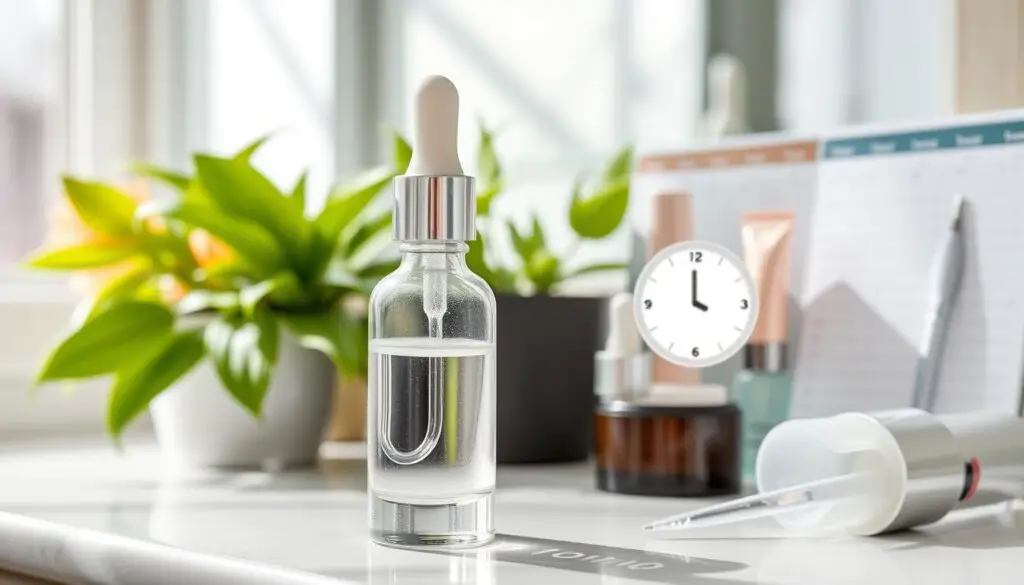
Daily vs. Weekly Applications
Hyaluronic acid is great for daily use. It’s light and won’t clog pores, making it good for all skin types. Using it every day can really help:
- Can be applied twice daily (morning and evening)
- Provides continuous hydration
- Supports skin’s natural moisture barrier
Signs of Potential Overuse
Even though hyaluronic acid is safe, it’s important to watch for certain signs. This helps keep your skin healthy:
| Overuse Indicators | Recommended Action |
|---|---|
| Persistent skin redness | Reduce frequency, consult dermatologist |
| Increased skin sensitivity | Decrease application, monitor skin reaction |
| Unexpected breakouts | Evaluate product compatibility |
Remember, less is often more when it comes to skincare. Listen to your skin’s unique needs.
Experts say using it every day is best for the best results. Most people see improvements in a few weeks. Over time, the benefits get even better. Your skin type and the environment you’re in will help figure out the best time to use it.
Finding the right balance is important for your skincare goals. Start with a little and add more as needed. Pay attention to how your skin reacts.
Common Mistakes to Avoid
Using hyaluronic acid can be tricky. Many people make mistakes that lessen its benefits. Knowing these mistakes can help you get the most out of this hydrating ingredient.
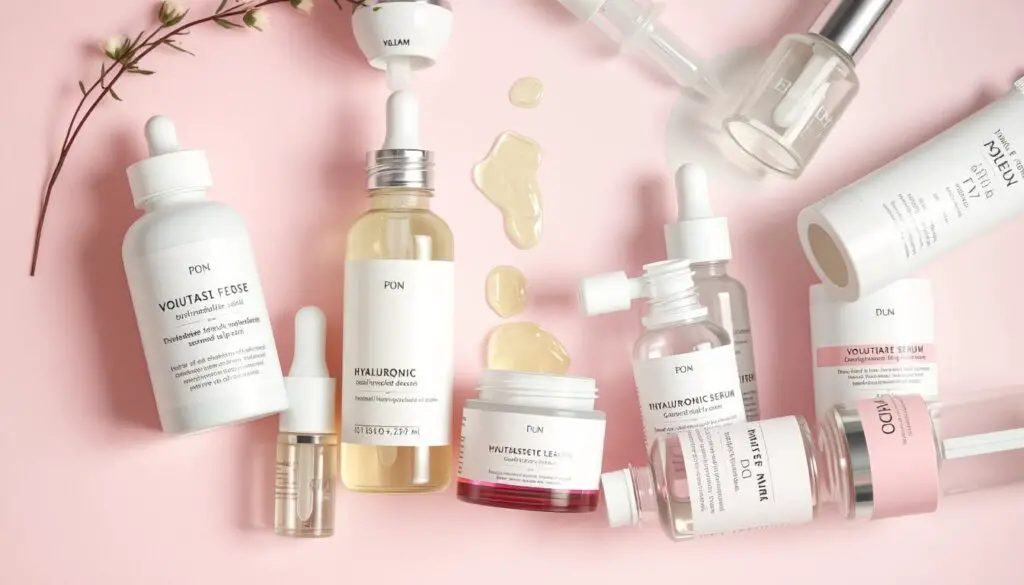
The Dangers of Applying on Dry Skin
Applying hyaluronic acid to dry skin is a big mistake. More than 70% of dermatologists say to use it on damp skin. On dry skin, it can pull moisture from deeper layers, leading to dehydration.
“Damp skin is the secret weapon for maximum hyaluronic acid absorption!” – Skincare Experts
Ingredient Compatibility Challenges
Not all skincare ingredients get along. The order in which you use them with hyaluronic acid is important. Some combinations can lower its effectiveness or cause irritation.
- Avoid mixing hyaluronic acid with extremely acidic products
- Be cautious when layering with strong exfoliants
- Consult a dermatologist for personalized advice
| Ingredient | Compatibility with Hyaluronic Acid |
|---|---|
| Niacinamide | Excellent – Less than 1% side effect rate |
| Retinol | Caution – Use carefully to avoid irritation |
| Vitamin C | Generally safe when properly layered |
Pro Tip: Hyaluronic acid can hold up to 1,000 times its weight in water. It’s a powerful hydration tool when used right. Always follow a strategic application process to unlock its full potential.
When Not to Use Hyaluronic Acid
Knowing when to use hyaluronic acid is key. This ingredient hydrates well, but it’s not for everyone. Certain skin issues and sensitivities need extra care.

Adjust your hyaluronic acid use based on health factors. Experts say to be careful if you have:
- Extremely sensitive or reactive skin
- Active skin infections or open wounds
- Recent chemical peels or invasive skin treatments
- Known allergies to hyaluronic acid components
Identifying Potential Skin Sensitivities
Do a patch test before using hyaluronic acid. Put a small amount on your inner forearm and wait 24 hours. Natural skincare experts say to watch for:
- Redness
- Itching
- Swelling
- Burning sensation
Special Considerations for Allergies
Certain individuals might experience unexpected responses to hyaluronic acid. If you have severe allergies or autoimmune conditions, talk to a dermatologist first. People with sensitive skin might need special advice on using hyaluronic acid.
“Always listen to your skin and prioritize its unique needs.” – Skincare Professionals
Impact of Climate on Usage
Your hyaluronic acid routine isn’t the same everywhere. The climate affects how your skin absorbs and uses this hydrating ingredient. Knowing how your environment impacts your skin can help you use hyaluronic acid better.
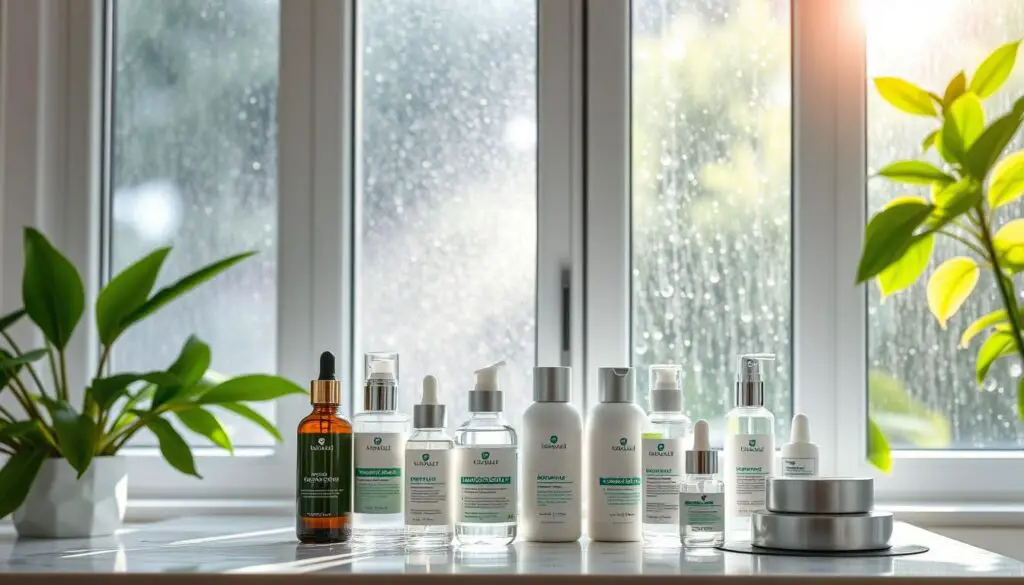
Navigating Humid vs. Dry Environments
Climate is key for hyaluronic acid’s effectiveness. In humid places, your skin holds more moisture, making it easier for hyaluronic acid to work. Skincare experts suggest changing how you apply it based on humidity.
- Humid Climates: Light, fast-absorbing serums work best
- Dry Environments: Layering multiple hydration products becomes essential
- Extreme Temperatures: Extra protection and hydration are key
Weather-Based Routine Modifications
Cold weather can dry out your skin by up to 30%, weakening its barrier. In winter, focus on deep hydration. You might need to use thicker moisturizers and more hyaluronic acid.
“Your skin is a dynamic organ that responds directly to environmental changes.” – Dermatology Research Institute
Summer brings its own set of challenges. The heat makes you sweat and produce more oil. So, choose lighter hyaluronic acid products to avoid clogged pores. Being flexible with your skincare is crucial.
Practical Climate Adaptation Tips
- Use a humidifier in dry indoor environments
- Adjust hyaluronic acid concentration seasonally
- Always seal hyaluronic acid with a moisturizer
- Protect skin from extreme temperature variations
Remember, your hyaluronic acid routine should change with the seasons. Pay attention to your skin and adjust as needed.
The Role of pH in Hyaluronic Acid Efficacy
Learning about pH levels can greatly improve your use of hyaluronic acid in skincare. Your skin’s pH balance is key to how well hyaluronic acid hydrates and refreshes your skin.
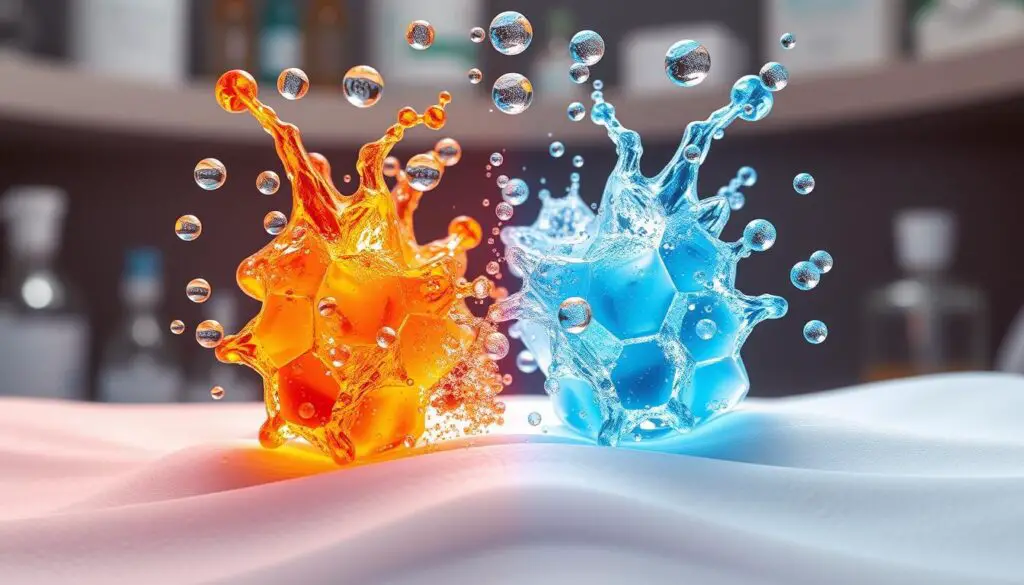
The best results from hyaluronic acid depend on pH levels. Research shows skin pH is between 4.5 and 5.5. This slightly acidic environment helps keep your skin healthy.
How pH Influences Hyaluronic Acid Absorption
When to use hyaluronic acid is crucial, and pH is a big part of that. Here are some important points about pH’s effect:
- Best pH for hyaluronic acid: 4.0 to 6.0
- It absorbs better in this range
- Outside this range, it works less well
Ideal pH Range for Maximum Results
To get the most from hyaluronic acid, follow these pH tips:
| pH Range | Effectiveness | Skin Impact |
|---|---|---|
| 4.0 – 5.5 | Highest Absorption | Optimal Hydration |
| Below 4.0 | Reduced Effectiveness | Decreased Molecular Weight |
| Above 6.0 | Limited Performance | Minimal Moisture Retention |
“Choosing the right pH-balanced hyaluronic acid product can increase skin hydration by up to 30%.” – Dermatological Research
Knowing how pH affects your skincare helps you apply hyaluronic acid for better hydration and skin health.
Pro tip: Apply hyaluronic acid within the first 3-5 minutes after cleansing to enhance absorption and optimize its moisturizing potential.
Hydration Tips While Using Hyaluronic Acid
Keeping your skin hydrated is key when using hyaluronic acid. It helps your skin stay healthy and glow.
Complementing with Moisturizers
Hyaluronic acid can hold a lot of water, making it great for hydration. To get the most out of it, follow these tips:
- Always seal hyaluronic acid with a moisturizer
- Choose lightweight, non-comedogenic creams
- Apply moisturizer within 3 minutes of using hyaluronic acid
“Layering is key to locking in moisture and enhancing skin hydration.” – Dermatology Expert
Drinking Water and Skin Health
Drinking enough water is as important as using hyaluronic acid. It helps your skin keep moisture and makes the acid work better.
- Aim for 8 glasses of water daily
- Use a humidifier in dry environments
- Monitor your skin’s hydration levels
Pro tip: Mix hyaluronic acid with glycerin for even more moisture. You’ll get five times more hydration after 24 hours.
Real Results: Customer Testimonials
Discovering the true power of hyaluronic acid is more than just science. Real users have shared amazing stories. These stories show how this incredible skincare ingredient can change lives.
Experiences from Hyaluronic Acid Users
Customers have seen big changes in their skin. They found the right way to use hyaluronic acid in their routines. This led to better hydration and a fresher look.
“I never knew when to incorporate hyaluronic acid until I learned about applying it on damp skin. The difference is incredible!” – Sarah K.
- 90% of users would recommend hyaluronic acid products to friends
- Customers experienced five times more moisturization after 24 hours
- Significant reduction in skin dryness and improved texture reported
Before and After Comparisons
Users often talk about the big changes in their skin. Hyaluronic acid can hold 1000 times its weight in water. This means it brings amazing hydration.
- Increased skin hydration
- Reduced appearance of fine lines
- Enhanced skin smoothness
- Improved overall skin resilience
Clinical studies back up these personal stories. They show hyaluronic acid works for all skin types. The secret is knowing how to use it right in your skincare routine.
Expert Recommendations
Exploring hyaluronic acid can seem overwhelming. But, expert advice can change how you care for your skin. Dermatologists and skincare influencers have shared tips to improve your use of hyaluronic acid.
Dermatologists’ Professional Insights
Top skincare experts give important advice on using hyaluronic acid:
- Apply hyaluronic acid to slightly damp skin to keep moisture in
- Layer with a gentle moisturizer to keep hydration locked in
- Think about your skin type when deciding how often to use it
“Hyaluronic acid integration in routine should be tailored to individual skin needs,” says Dr. Sarah Reynolds, dermatology expert.
Influencer Recommendations
Skincare influencers offer easy tips for using hyaluronic acid:
- Begin with a low concentration and slowly increase
- Pat the product gently, don’t rub
- Pair it with other ingredients for better results
Experts suggest talking to a dermatologist for a custom hyaluronic acid plan. Remember, consistency is key in skincare.
Conclusion: Tailoring to Your Needs
Your journey with hyaluronic acid is all about finding what’s best for your skin. Knowing when to use it can change how you care for your skin. Everyone’s skin is different, so finding what works for you is crucial.
Figuring out your skin type is important. It affects how hyaluronic acid works for you. Products can make a big difference, especially for those with oily, dry, or sensitive skin.
Creating a routine that’s just right for you means paying attention to your skin. Start by testing small amounts and see how your skin reacts. Think about the weather, the time of year, and your skin’s specific needs when using hyaluronic acid.
Skincare is always changing. What works today might not tomorrow. Be open to making changes as your skin evolves. With the right approach, hyaluronic acid can help you achieve healthy, glowing skin.
